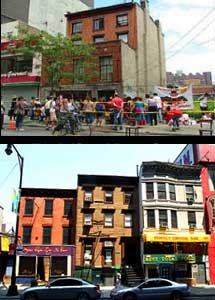
A Google
News search for "Bovis" brings up a huge number of articles about the recent deadly fire at the Deutsche Bank building at the World Trade Center. A
news search for "ESDC" brings nothing, which is odd when you think about it. The New York State Economic Development Corporation is in charge of this area.
Public authorities, which include the ESDC and the New York City Economic Development Corporation (EDC), were created to cut through the red tape that prevents development. That's all well and good, but the case of the Deutsche Bank Fire, that manifested into a disconnected water standpipe.
Public authorities have been failing to address environmental concerns in various ways in various projects. At the proposed Atlantic Yards development, where the ESDC is nominally the lead developer, the collapse of the parapet of the Wards Bakery led to
promises of an Ombudsman... which never materialized. In Harlem, a judge recently ruled that there
appeared to be collusion between the ESDC, AKRF and Columbia University.
The controversy over environmental oversight in the Downtown Brooklyn redevelopment plan includes another aspect of what the state defines as "environment," namely historic resources. The experts hired by the EDC through its contractor AKRF came to the conclusion that the Duffield Street homes should be preserved, but the EDC ignored their advice.
These are just part of the problems of public authorities like the ESDC. An audit released in May 2006 by New York comptroller Alan Hevesi reported that the Corporation loses track of its subsidiaries and recommended that "significant improvements be made in ESDC’s recordkeeping for and control over subsidiary operations."
Firms like Bovis and AKRF are for-profit businesses accountable to their owners. They are taking advantage of a situation created by public authorities like the EDC and the ESDC. (AKRF has a tenuous connect to the Deutsche Bank fire, since its role was limited to leading the team that wrote the GEIS.)
Neither our mayor or nor governor seemed to be concerned about insuring that the public authorities serve the public.
The mayor and governor are supposed to serve the citizens. But if they are not doing their job, it is up to the citizens to force them to do the right thing.
It sounds idealistic to say that the citizens should really be in control, but what choice do we have after the Deutsche Bank fire? What choice do we have when the mayor wants to destroy the Duffield Abolitionist homes to build a parking lot?











